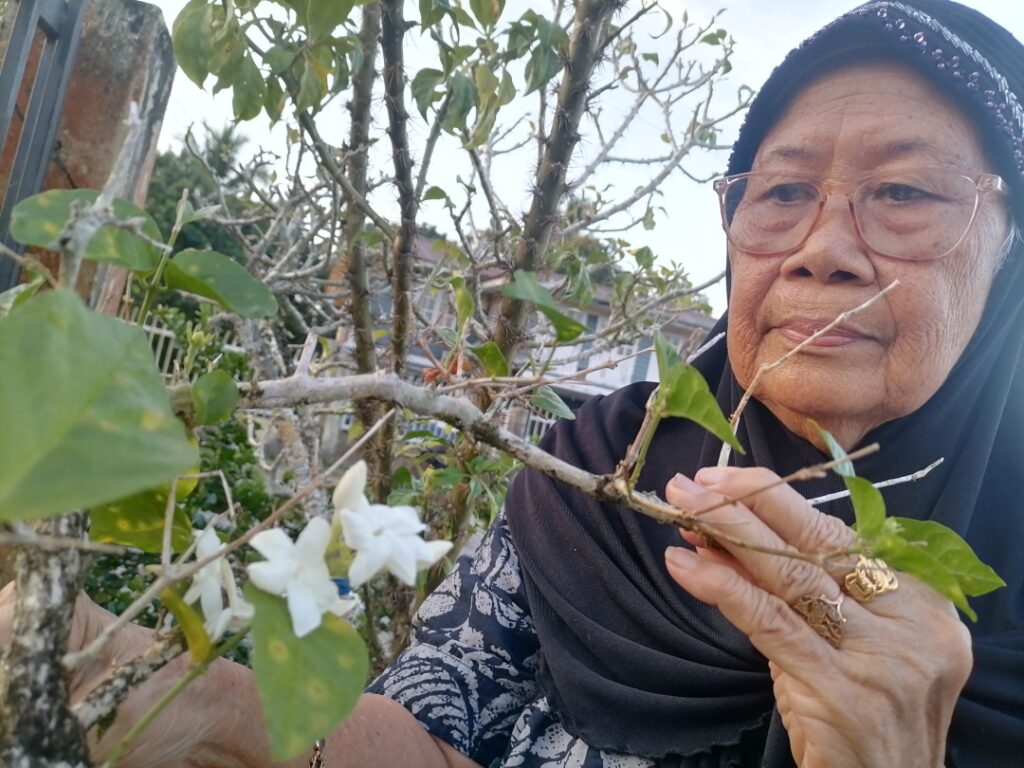Stephanotis floribunda is the scientific name for this group of flowering vines. Its other names include Clustered Wax Flower, Hawaiian Wedding Flower, Bride’s Flower and Madagascar Jasmine.
I REMEMBER having first come across this ‘white gem’ – its strong fragrance would wake me up whenever I came close to the flowers.
There was a time when home gardening was very active, where we could seek information for the gardening feature called ‘POSTmag’ back then.
There were several nurseries in Kuching that would always be looking up for new varieties for sale. I was lucky to have seen the Stephanotis overseas (Australia) and coming back, I tried to look for it locally — it was hard to find.
Then one day, Mr Paul Teo – a former teacher of SMK Batu Lintang in Kuching who after retirement, has become a horticulturist – introduced it to me.
Instantly, my memory of this ‘little white gem’ rekindled.
Mr Teo showed me a plant, standing over 10 feet tall, trailing in a flower shade with a large fruit like a pear.
My latest discovery again was at the Mile 3 Wet Market, and I bought it.
The Stephanotis is a flowering plant that needs some special attention, indeed.
Origin
Stephanotis floribunda is the scientific name for this group of flowering vines.
Its other names include Clustered Wax Flower, Hawaiian Wedding Flower, Bride’s Flower and Madagascar Jasmine. It belongs to a family called Apocynaceae, as evergreen vine with waxy leaves and tubular flower morphology.
The name derives from Greek ‘stephanōtís’ (a woman’s crown).
Cultivation
This plant is a climbing vine with bright lavish green foliage that requires a trellis to support the stems and branches, which could extend well over 10 feet (over 3m).
Let it climb over the trellis or a pergola to represent a charming bundle of snow-white flowers amongst the green leaves.
The vine can be arranged around a circular support to provide a good shape.
Growing medium needs a rich loamy soil that can retain constant moisture. It requires potting mix high in compost, but not in a water-lodge condition.
Organic compost is preferred, and top mulching helps in moisture-retention.
It is good to find a bigger clay-pot for good drainage and good rooting. The size of the pot is also critical – being too big is good for growing leaves, but the plant would produce less flowers. So it is advisable to use a 10-inch pot, which is good enough.
Stephanotis needs bright light, which is good in the case of our warm, tropical climate.
Less light may prevent flowering and could result in the premature death of the leaves.
The plant can withstand up to 30-degree Celsius, but not in conditions that are either too hot or too cold.
Water the plant regularly – on a daily basis, if there’s no raining. It would be best using rain-water and not tap-water, as the latter has been treated with chemicals that are not good for tender plants.
‘Feed’ the plant by scattering pallets on top of the soil, allowing water to dissolve slowly down at the rate of once a month; a slow-release fertiliser would be an added advantage. Nutrient solution is ideal as the absorption by the roots is quickly available to the plant.
NPK formulas like 5-5-5 should do the job, but to encourage flowering, one can try High K and P especially.
Steps to successful planting
1. To start, we need to buy small, potted vines in good health with glossy leaves, but best to not get those that are too old and placed in the polybags or containers.
2. It requires location with good morning and afternoon sunlight, without leaving it too hot in our climate condition.
3. The growing medium should be rich with organic compost and porous enough to ensure good drainage and aeration to the roots.
4. Mulch the soil surface to preserve moisture.
5. Nutrients for growth and flowering is best applied twice a month. Organic manure is good.
6. Water generously to ensure medium is moist without drowning the roots.
After-care measures to ensure flowering
1. Pruning may be required to avoid overcrowding of the foliage, or after flowering.
2. If leaves turn yellowish prematurely, it is a sign of nutrient deficiency – add nitrogen-rich fertiliser or the right formulated fertiliser.
3. Pests such as mealybugs and sooty mould may appear after some time, especially under shade. Use white or a mixture of soap solution to ‘bathe away’ the pests.
Do not be afraid to do trials – if done right, the rewarding outcome is one that you can truly enjoy, and also, it can cheer up your garden and home environment, especially during these trying times.
Happy Gardening!

